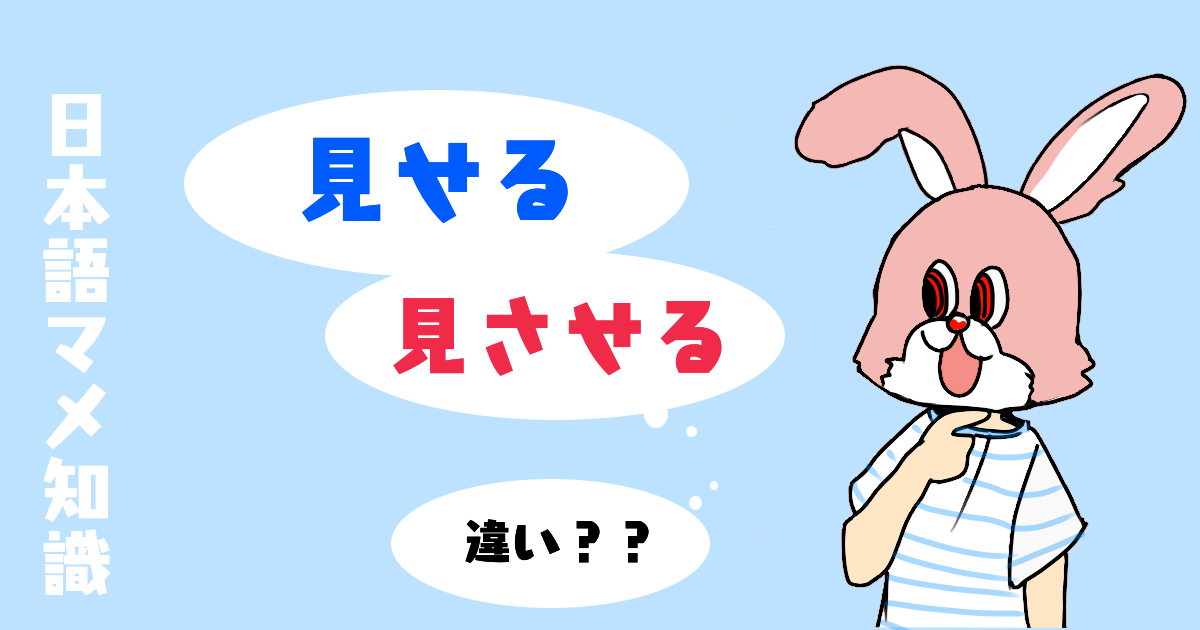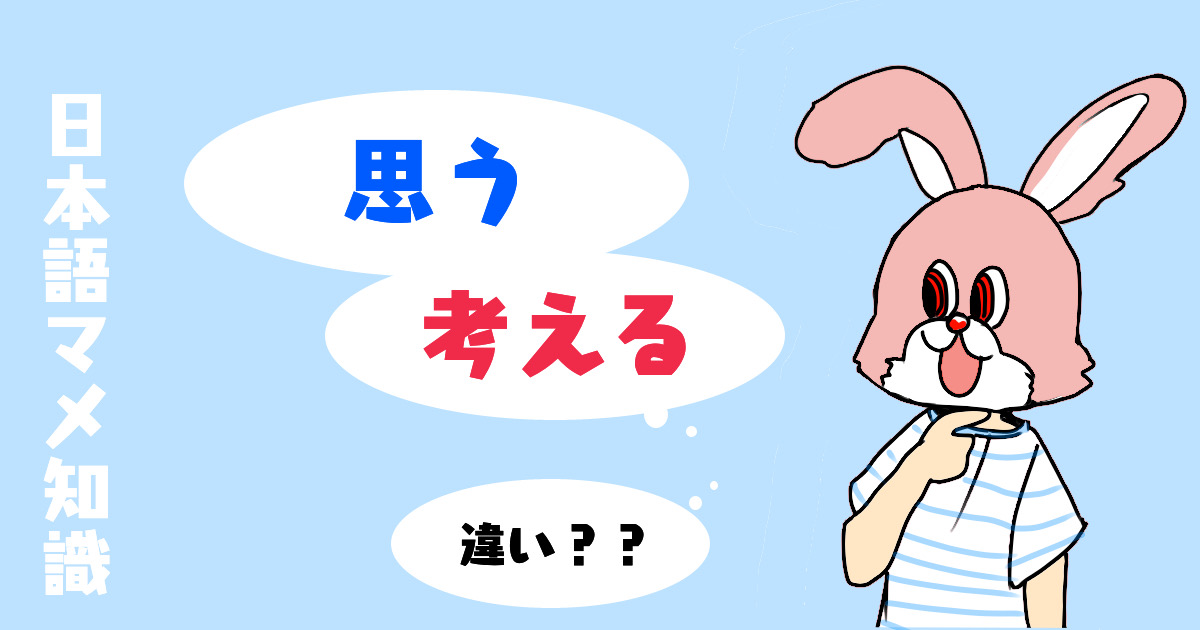
先生~!外国の友だちに「テレビ見せて」と言ったら、「見せる」は間違いだと言われたんですが、本当ですか⁉︎ Teacher! When I told my foreign friend, “Misete(Let me see the TV)”, they said that using miseru (“to show”) was wrong. Is that true!?

なるほど、その人は最近「使役形」を学んだようですね。大丈夫。「見せる」という言葉は間違ってません。I see — it sounds like that person recently learned about the causative form in Japanese. Don’t worry, the word miseru isn’t wrong.

なぜ間違いと言われたんでしょうか…? Why did they say it was wrong, then…?

「見る」を使役形(せる・させるの形)にすると「見させる」が正しいからです。けれど、「見せる」という単語もそもそも存在するんですよね。ややこしいことに。Because when you turn miru (“to see”) into its causative form (the “seru / saseru” form), it becomes misaseru (“to make/let someone see”). But the word miseru also exists as a separate verb — that’s what makes it confusing.

ヒエ~ッ!じゃあ「見せる」と「見させる」の違いって何なんですか⁉︎ Whoa! Then what’s the difference between miseru and misaseru!?
「見る」の使役形「見させにとって見せる」は、外国人にとって違いが分かりにくいものです。ここでは、「見る・見せる・見させる・見させられる」などの意味と文法の使い方、違いを例文と英語付きでわかりやすく解説していきます。ビジネスシーンでも使える正しい表現方法を紹介します。
For foreign learners, it’s often hard to tell the difference between the causative form misaseru of miru and the verb miseru. In this explanation, we’ll clearly go over the meanings, grammar, and differences between miru, miseru, misaseru, and misaserareru, along with example sentences and English translations.
見せると見させるの違いとは
日本語には、「見せる」と「見させる」という似た表現があります。【見せる】【見させる】を区別して使っている日本人はそこまでいないかもしれません。しかし、これらには微妙な意味の違いが存在し、正しい使い分けが求められる場面もあるかもしれません。
In Japanese, there are two similar expressions: “miseru” (見せる) and “misaseru” (見させる). Many Japanese speakers may not always distinguish carefully between them, but there is a subtle difference in meaning. In certain situations—especially in formal or business contexts—it’s important to use them correctly.
「見せる」の意味・活用・例文
- 見せる…相手に何かを見させる行為であるが強制的ではない。The act of showing something to someone, but not in a forceful way.
- 自分の意思で相手が何かを見ることを促すときに使います。It’s used when you encourage or allow someone to see something out of your own will.
- 文法用法:下二段活用動詞(~ないの形にしたときエ段で終わる)Ru-verb / Group2.
- 英語:show / let A see / let A look at /let A watch
①見るように促す: 相手が自発的に見る行為を導く。
To prompt someone to look: To guide or invite someone to look voluntarily.
②表現する: 内面的な感情や態度を外に表す。To express: To outwardly show one’s inner feelings or attitude.
③理解させる: 相手に何かを実感させるために見せる。例文:①見るように促す(強制的ではない)
「子どもに英語ビデオを見せる。」Show the child an English video.
「生徒にニュースを見せて、考えさせる。」Show the news to the students and make them think.
「病気の彼女に月を見せる。」Show the moon to my sick girlfriend.
「え、何それ、見せて。」Huh? What’s that? Show me.
例文:②表現する
「時間を気にする様子を見せる。」Show signs of being concerned about the time.
例文:③受けさせる/分からせる/理解させる
「格の違いを見せる。」Demonstrate the difference in level / Show superiority.
「見させる」の意味・活用・例文
- 見させる…相手に強制的に何かを見させる行為、または相手の行動への許可。The act of forcing someone to see something, or allowing someone to do so.
- 相手の意思に関わらず、何かを見させる場合によく使用。It is often used when the person has no choice, or when permission is being granted.
- 文法活用:「見る」の使役形、下二段活用動詞(~ないの形にしたときエ段で終わる)Causative form of miru (見る) ,Ru-verb / Group2.

ちなみに「見る」は五段活用動詞(~ないの形にしたときア段で終わる)ですが使役形にするとグループが変わります。Interestingly, when miru is turned into the causative form, its verb group changes.
①目で認識させる(強制的)To make someone see (by force or direction)
②判断させる To make someone judge or evaluate
③調べさせる To make someone examine or investigate
例文:①目で認識させる(強制的)
「嫌がる子どもに教育テレビを見させる。」Make the unwilling child watch educational TV.
例文:②判断させる
「学生同士でレポートを見させる。」Have students review each other’s reports.
例文:③調べさせる
「研究者に月の結晶を見させる。」Have the researcher examine the moon’s crystals.
見せると見させるの違いは強制力
「見せる」と「見させる」の違いは、その強制力にあります。
The difference between “miseru” (見せる) and “misaseru” (見させる) lies in the degree of compulsion involved.
②「子どもに映像を見させる。」Make the child watch the video.
①「子どもに映像を見せる。」では、子どもは嫌がっていません。主体的に子どもは映像を見ていることになります。②「子どもに映像を見させる。」では、子どもはあまり乗り気ではないかもしれません。親が無理矢理させている意味が強くなります。
In ①, the child is not unwilling; they are watching the video voluntarily. In ②, the child might not really want to watch it. The nuance is that the parent is forcing the child to do it.

ただし、日常会話では、多くの人が違いを意識しないで使っています。However, in everyday conversation, many people use these two forms without paying attention to the difference.
許可・容認の「見させる・見せる」の場合
ここまでで「バッチリ分かった!もう十分!」な方は、ここは読み飛ばして下さい。少しこんがらがることを言います。If you already fully understand the difference above, you can skip this part — it gets a bit more complicated.
これは、強制的ではないですね。このような場合、使役形は「許可や容認」の働きを持ちます。使役形は強制だけでなく、以下のように許可や容認の意味を付けることができます。
In this case, misaseru doesn’t mean “force.” It expresses permission or allowance.
The causative form in Japanese doesn’t always imply coercion; it can also carry the meaning of allowing or permitting someone to do something.
「今日休ませていただきたいのですが…。」I’d like to take the day off today, if that’s alright.
「すみません、ちょっと本を取らせてもらってもいいですか?」Excuse me, may I take that book for a moment?
「2人は愛し合っている。ぼくは娘をアメリカ人と結婚させることに賛成だよ。」They’re in love. I agree to let my daughter marry an American.
「子どもを大学に入らせる。」Let my child go to college.
見せる・見させるの英語訳は?
「見せる」と「見させる」は、英語訳するとより分かりやすいでしょう。英語の使役形には【let】や【make】を使いますね。
show / let A see / let A look at /let A watch(Aに見せる)
make A look at /make A watch/force to look at /force to watch(無理に見させる)
ただし、「見させる」の認識によっては、英語訳が「let A see」の形になっていることがあります。
「英語のドラマを見せているの。」I let him watch an English program.
泣くほど嫌な太郎くんですから、「ドラマを見させる」が正しいはずです。が、日本語も英語も「見せる」になっています。ここでは、話者が強制ではないと感じていることが伺えます。ちなみに、太郎くんからすると、「英語番組を見させられている」状態です。
「見せる・見させる」と「見せられる・見させられる」の違い
「見る」と似ている言葉には、「見せる」「見させる」の他にも、「見せられる」「見させられる」があります。よく聞きますが、どのような意味の違いがあると思いますか?
Among the words similar to “miru” (見る, to see/watch), there are not only “miseru” (見せる, to show) and “misaseru” (見させる, to make someone see/watch), but also “miserareru” (見せられる) and “misaserareru” (見させられる).You may have heard these forms often — but what do you think is the difference in their meanings?

「見せられる」「見させられる」…混乱してきました…。It’s starting to get confusing.
「見させられる」の意味・活用・例文
- 見させられる…見させる(強制)+られる(受身)
- ムリヤリ誰かによって見ることを強要される状態。This form expresses that someone is forced to watch or see something against their will.
- 受身形を取ることで、「より強制された」という印象。By taking the passive form, it gives a stronger impression of being compelled or having no choice in the situation.
- 文法活用:下二段活用動詞 Ru-verb / Group2.
- 英語:be made to watch
「昨日ママに英語のDVD見させられたんだ。」
「あの人と付き合うとホラー映画ばっかり見させられるよ。」
「彼の嫌なところばっかり見させられて、ウンザリ。」
「見せられる」の意味・活用・例文
- 見させられる…見せる(強制じゃない)+られる(受身)
- 強制ではないが、話者が受身的に見たこと。This form indicates that the speaker was shown something, often in a way that’s somewhat passive but not necessarily forced.
- 文法活用:下二段活用動詞 Ru-verb / Group2.
- 英語:be shown, be made to see(迷惑な場合)
「先生に日本語の活用全部見せられたんだけど…やる気なくなっちゃった。」The teacher showed me all the Japanese conjugations… and I totally lost my motivation.
「力の差を見せられたよ。もっと がんばらないと。」I was shown the difference in our abilities. I really need to work harder.
「見させられる」と「見せられる」の違い
【見る】の使役形→「見させる」の受身形→「見させられる」
それぞれ、受身形ですが、【見させられる】は使役形+受身形です。「見させられる」は、強制されてウンザリした気持ちが強く、「見せられる」は、そこまで強制されたわけではありません。

使い分けができたら、使役形/受身形はバッチリです!
「見さされる」は間違い!その理由は?
日本語の使役受身形を学んでいると、「見さされる」という表現を聞いたことがあるかもしれません。しかし、この表現は文法的に間違っています。では、なぜ「見さされる」が間違いであるのかを詳しく解説します。
When studying the causative-passive form (shieki-ukemi-kei) in Japanese, you may have come across the expression “misasareru” (見さされる). However, this expression is grammatically incorrect. Let’s take a closer look at why “misasareru” is wrong.
使役受身形の基本ルール
まず、基本的な日本語の文法ルールとして、「見させる」は「見る」の使役形で、「~させる」という形になります。そして、その使役形を受身形にすると「見させられる」になります。
First, according to basic Japanese grammar rules, “misaseru” (見させる) is the causative form of “miru” (見る, to see). The causative form is made using “~させる”. When we turn that causative form into the passive form, it becomes “misaserareru” (見させられる).
書きます→書かせます→書かせられます/書かされます
撮ります→撮らせます→撮らせら二れます/撮らされます
見ます→見させます→見させられます
おぼえます→おぼえさせます→おぼえさせられます
します→させます→させられます
きます→こさせます→こさせられます
なぜ「見さされる」の間違いが多い?
「見さされる」の誤用は、五段活用動詞(1グループ)の動詞の使役受身形が変化することに起因します。例えば、「書きます」の使役形は「書かせます」。使役受身形は、「書かせられます」です。しかし、この使役受身形の「せら」を「さ」と言ってもいいというルールがあります。
The incorrect usage of “misasareru” (見さされる) comes from the way the causative-passive form of Group 1 (godan) verbs changes. For example, the causative form of “kakimasu” (書きます, to write) is “kakase-masu” (書かせます). Its causative-passive form is “kakase-rare-masu” (書かせられます). However, in Japanese grammar, there is a rule that allows the “-serare-” (せられ) part in these cases to be shortened to “-sareru” (さ れ).
行かせられます→行かされます
急がせられます→急がされます
買わせられます→買わされます
払わせられます→払わされます
撮らせられます→撮らされます
※「話します」のような「ます」の前が「し」の時は変えられない
これと同じように「見ます」→「見させます」→「見させられます」→「見さされます」にすると間違い。なぜなら「見ます」は上二段活用動詞(2グループ)の動詞で、活用形が異なるからです。「見ます」の使役受身形は、「見させられます」が正解です。
In the same way, if you try to apply this pattern to “mimasu” (見ます) —
→ “misasemasu” (見させます) → “misaseraremasu” (見させられます) → “misasaremasu” (見さされます) —the last form “misasaremasu” is incorrect. This is because “mimasu” (見る) is a Group2verb, and its conjugation rules are different from those of godan (Group 1) verbs. Therefore, the correct causative-passive form of “mimasu” (見る) is “misaseraremasu” (見させられます).
「見せてください/見させてください」は正しいビジネス敬語?
「見せてください」「見させてください」は、ビジネスやフォーマルシーンで使える正しい日本語なのでしょうか?文法的に、間違いはありません。しかし、捉え方によっては誤解を招くので、ビジネスシーンや目上の人に使わないのが無難。ビジネスやフォーマルな場面では、「見せてください」や「見させてください」は適切でない場合があります。
Are “misete kudasai” (見せてください) and “misasete kudasai” (見させてください) correct Japanese for business or formal situations? Grammatically, they are correct, but depending on how they’re perceived, they can easily cause misunderstandings. Therefore, it’s generally safer not to use them when speaking to superiors or in formal business contexts.
理由は、①イヤミに感じる人がいる②フランクすぎると感じる人がいるため。さらに、「見させてください」だと、見たくもないのに見ようとしている感じがするからです。特に、敬意を欠く表現と受け取られることもあるため、慎重に使用する必要があります。
In business or other formal situations, “misete kudasai” and “misasete kudasai” can sound inappropriate for two main reasons:①Some people may find them sarcastic or impolite. ②Others may feel they sound too casual or forward.In particular, “misasete kudasai” can give the impression that you’re trying to look at something you weren’t invited to see, or that you’re forcing your will onto the other person. It can even be taken as disrespectful, so it should be used with care.
謙譲語を使って: 「拝見させていただけますでしょうか?」May I have the honor of taking a look?
尊敬語を使って: 「お見せいただけますでしょうか?」Would you kindly show me (something)?
これらの表現は、相手に対する敬意をしっかりと示すため、ビジネスシーンにおいても安心して使用できます。「拝見させてください」「拝見します」などの謙譲語を使うか、相手を主語にして「お見せください」などの尊敬語を使うのが良いでしょう。
These phrases clearly express respect toward the other person and are perfectly suitable for business or formal settings. In such contexts, it’s best to use humble forms like haiken shimasu(拝見します) or make the other person the subject, as in o-mise kudasai(お見せください).

友だち相手なら「見せて」、ビジネスでは「拝見します」がおすすめです。
When speaking casually with friends, “misete” (見せて) is perfectly fine.
In business, however, stick to “haiken shimasu” (拝見します) or “haiken sasete itadakimasu” (拝見させていただきます).

「ノートを見させてもらおうか!」なんて言うと、完全に悪役キャラですもんね。After all, if you say something like, “Let me see your notebook… if you dare!!” you’ll sound completely like a villain in an anime!

ちなみに、「見える」と「見られる」の違いが知りたい人は、こちらもチェックしてみてください。By the way, if you’re also interested in the difference between “mieru” (見える) and “mirareru” (見られる), be sure to check that out too!
まとめ
- 【見せる】は、強制的でない。
英語では、show/let A see(look at/ watch)
【見せられる】は【見せる】の受身形
- 【見させる】は、強制的な意味を持つ場合がある。
英語では、make A look at(watch)/force to look at(watch)
【見させられる】は【見させる】の受身形
- 「見せてください」「見させてください」はビジネスNG
前回記事:【倫理】と【道徳】の違いとは?
次回記事:「~(する)ために」と「~(する)ように」の違いとは?




コメント